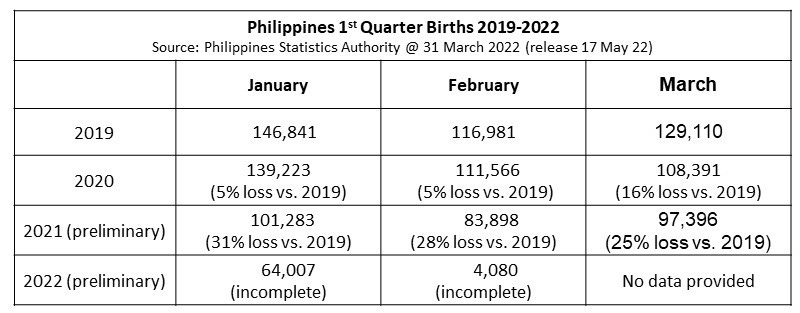Philippines: What will happen when a Successful Family Planning Campaign meets the Covid-19 Pandemic Intervention? Accruing 2022 International Data Shows Plummeting Birthrates? Population Collapse?
Live Births in Philippines show a sharp downward trend starting in 2020 and continuing into 2021. Most of this change cannot be attributed to covid-19 measures! 2022 Births though, will be telling!
Birthrates in the Philippines have been slowly dropping over time (Source: PSA). All data used in this article is from PSA archived reports.
In 2020 there was a big drop in birthrates of 9% compared to 2019 (the last “typical” year). In 2021 there was an even bigger drop, relative to 2019 of 22%. Crude Birth Rates (CBR), which are adjusted to reflect total population count, dropped from 19.7 in 2007 to 15.6 in 2019, a loss of 4.1 live births/1000 population / year over 12 years (average loss of 0.34 CBR/year). Then in 1 year from 2019 to 2020 there was an additional loss of 1.5 live births/1000 population, and in 2021 a further loss of 2.1 live births/1000 population to bring the latest CBR down to about 12 (est. by me).
Remembering that pregnancy takes 9 months, factors affecting births in 2020 must have started early in 2019 well before the pandemic was called. While lockdowns would have magnified economic pressures encouraging family planning in 2020, the vaccines also cannot be directly blamed for the drop in births in 2021 (shedding concerns aside) because vaccine delivery started in March of 2021 to health care workers, the general population by mid-year, and to pregnant women in August of 2021; affected babies were not due to be born until the last quarter of 2021 (for 3rd trimester vaccine dosing), and more generally in 2022.
Monthly Birth Rates for 2019, 2020, and 2021 are plotted. Quite a staggering change.
We have to look at this reduction in births against backdrop of comprehensive and recently widely accessible family planning services, likely combined with the economic drivers arising from a vibrant developing economy (likely true demographic transition until the excess deaths kicked in in 2021).
Background for Family Planning in the Philippines
The Philippines, a strongly Catholic Country, has long resisted family planning measure with contraceptives not being readily available until recently, and abortion including “morning after pill” being illegal.
The Responsible Parenthood and Reproductive Act of 2012 was signed into law in December 2012, and was implemented in April 2014 following a Supreme Court decision on its constitutionality. A temporary restraining order (TRO) on registration and/or certification of contraceptives / contraceptive devices followed. In early 2017, the Duterte administration issued an Executive Order to mitigate the effects of the TRO, and the DOH issued an Administrative Order on guidelines for achieving desired family size. At that time the Philippines committed to providing family planning services to poor families with zero co-payment, and to upgrading public health facilities and increasing the number of providers to provide reproductive information and support. This would have all taken time to implement, however it was implemented and was well underway by 2019. Thus, access to effective, widely available, and free family planning provide a rational explanation for the reduction in live births in 2020 and 2021!
International Reports of Widespread Baby Busts in the first Months of 2022
As discussed here by NakedEmperor, many countries are reporting big drops in births in the first months of 2022. Also discussed by Igor Chudov, Germany has reported a 13% drop in births (a 9-sigma event), though the Government ludicrously claims that the drop is simply because their citizens have had enough children and don’t want more. Taiwan has reported a 23.4% drop in live births of in the first quarter of 2022 compared to the same months in 2021. This is an inconceivable/ can’t happen 26 sigma event; 26 standard deviations from their mean historical change.
What Happens When Family Planning and the Covid-19 Intervention Collide?
For the Philippines, what will happen when we have strong family planning services, combined with what looks like (from international data) dramatically reduced fertility (likely) resulting from the covid-19 genetic modification vaccines?
If there is a further 8, 10, 20% or more drop in live births combined with the massively increased deaths (40+% excess mortality in 2021), a population implosion could be imminent?
While a slow and stable population growth is considered ideal, with the objective that each family have the numbers of children that they want, what if families are no longer able to bear those children? What if parents and caregivers of those children die prematurely? Will mass societal disruption and destabilization occur?
Philippines Statistics Authority Office Data is Critical
It is now the end of June; the vital statistics for January and February 2022 should be already substantially complete, and March and April data very well in progress (Referencing prior data releases, it takes about 4 months for relatively complete vital statistics data to be compiled).
Minimal and clearly incomplete 2022 vital statistics including data birth data was released by PSA last 17th May, preliminary as of 31 March 2022, and set out below, combined with other population birth data that I have on hand: -
PSA data is already critical for assessment of the population impacts of the covid-19 pandemic measures! We are waiting!






Thank you for sharing the data from the Philippines. If you can get more on-the-ground / anecdotal reports to help flesh out the situation, that would help provide additional context and colour, just fwiw. I followed you here from an El Gato article comment you made.
More, especially Philippinos, need to see your research. The COVID Blog says they get more from the Philippines
than any country besides the US. Maybe he would link to your Substack.